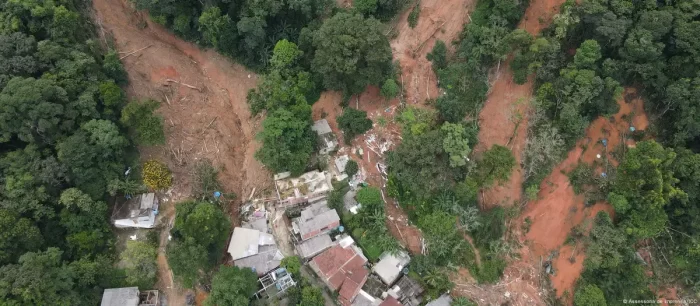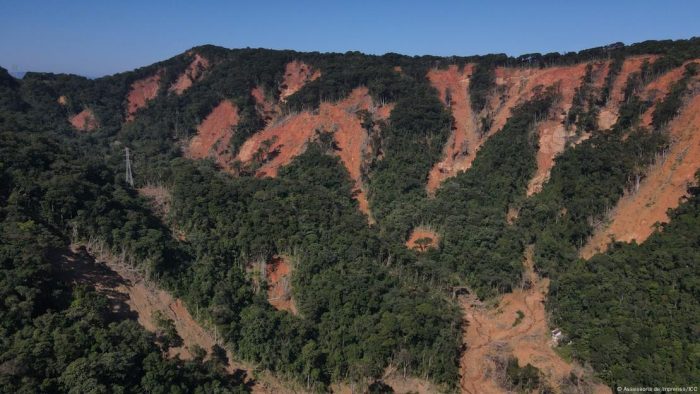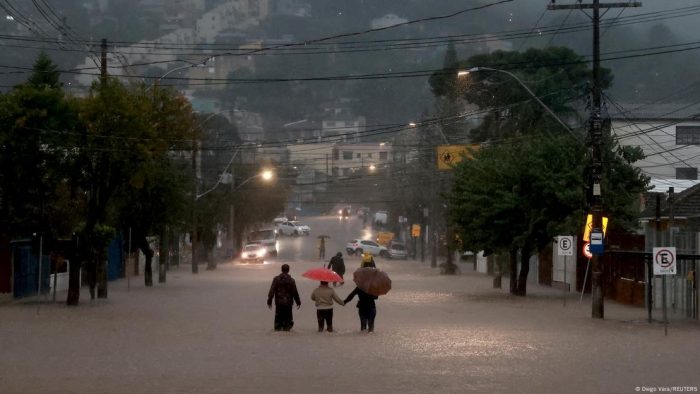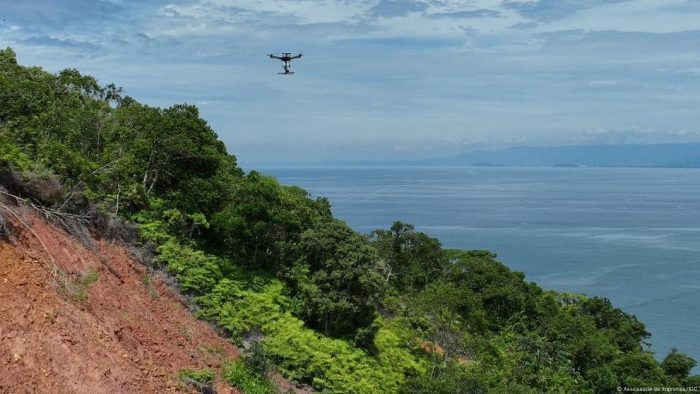
By Equipe de Redação
Posted in October 13, 2024

São Sebastião was the site of one of Brazil’s most recent environmental tragedies. The city experienced flooding that left thousands homeless and 65 dead. Photo: Press Office/ICC.
Like São Sebastião on the northern coast of São Paulo, the city is working to transform itself into a resilient place, prepared to withstand extreme events following the devastating rains of 2023.
Electrician Moiseis Bispo, 38, had just finished renovating his house when São Sebastião was struck by torrential rains that devastated the city in February last year. A community leader in Vila Sahy, Bispo had never seen anything like it. Water invaded homes, leaving thousands displaced and causing 65 deaths, leaving scars on both residents and the environment.
“It’s a trauma that will stay with us for life. Whether we remain here or leave, it won’t matter,” says Bispo, who fears the tragedy could repeat. Eighteen months later, however, São Sebastião is slowly healing its scars and finding new ways to address extreme weather events.
This month marks an important milestone in the recovery process. The final seeding for the Restaura Litoral Project—a program that mapped 851 landslide areas to accelerate vegetation regeneration—will be completed.
Using drones equipped with artificial intelligence, more than 1,000 kilograms of native tree seeds have been dispersed over 183 hectares of devastated land, reaching 90% of the project’s goal. The aim is to cover 200 hectares within the next two weeks.
The project is part of a broader initiative to make São Sebastião resilient to climate events. It also involves the creation of four conservation units and environmental education programs. “The takeaway from all this is the importance of environmental awareness,” summarizes Bispo.

Building resilient cities to withstand extreme weather events, as São Sebastião is attempting to do, remains a significant challenge across Brazil. Over the past decade, 94% of Brazilian municipalities have experienced some form of disaster, according to a report by the National Confederation of Municipalities (CNM), with most events caused by excessive rainfall and droughts.
Despite these recurring events, Brazil still struggles with disaster prevention. Between 2010 and 2023, the country invested around R$15 billion in response and recovery efforts but only R$7 billion in prevention, according to Talita Gantus de Oliveira, a researcher at the Institute of Geosciences, State University of Campinas (Unicamp).
“We act reactively, never prepared. The modus operandi is always reactive once disasters strike, like seasonal policies activated when it starts to rain,” says Oliveira, who studied urban planning for disaster management and resilience in her doctoral research.
The National Policy on Civil Defense was only established in 2012, following the rains that killed 900 people in Rio de Janeiro’s mountainous region in 2011. A study by the National Center for Monitoring and Early Warning of Natural Disasters (Cemaden) found that 59% of municipal civil defense departments consist of just one or two people, and 72% of municipalities have no budget for civil defense.
“Another issue is that most civil defense officials are not public servants, so each election cycle brings personnel changes, requiring new hires to be trained from scratch,” says Victor Marchezini, a sociologist at Cemaden.

Marchezini points out that inter-municipal coordination is often lacking in Brazil, complicating responses to events affecting multiple regions, as seen this year in Rio Grande do Sul.
In light of these recent events, the federal government plans to finance 200 Municipal Risk Reduction Plans (PMRR) by 2026 to map geological and hydrological risks in vulnerable areas. The first plan was completed this month for the city of Paulista in Pernambuco.
For Oliveira, this initiative represents progress, but Brazil will also need to tackle other challenges, such as creating continuous public policies, securing funding for municipalities, enforcing plans, investing in urban planning and quality housing, and combating real estate speculation in disaster areas.
“Resilience is a ‘buzzword’ that has been co-opted by the market as a gentrification practice. But resilience is about the community’s ability to mobilize,” he emphasizes.
Marchezini is coordinating a project called Cope/Fapesp (Organizational Capacities for Preparing for Extreme Events), which will begin mapping cities’ ability to deal with extreme events in 2025 and will conduct pilot training sessions in some locations.
“We can’t rely solely on Civil Defense agents to handle thousands of people, so we need sufficient public policies to engage and prepare citizens,” he says.

Community mobilization is precisely the driving force behind environmental and social initiatives focused on resilience in São Sebastião. The municipality benefits from being a seaside destination that attracts affluent tourism, which helped raise funds and organize efforts during the time of the tragedy, enabling the launch of the Restaura Litoral project.
This initiative involves the local NGO Instituto Conservação Costeira (ICC), the government through the Fundação Florestal, the Federal Public Prosecutor’s Office (MPF), and private sector partners.
Some of the funding for the project came from Concessionária Tamoios as compensation for the impact of building the new Tamoios Highway. This allowed the hiring of Atlântica Consultoria Ambiental, which conducted a five-step recovery plan for devastated areas, and Ambipar, which adapted drone technology to disperse seeds.
They use bio-capsules that would otherwise be discarded by the pharmaceutical industry and organic fertilizer derived from wastewater treatment plant residues.
“Given the unique geography of São Sebastião, with steep slopes and hard-to-reach areas, we had to modify the drones to quickly spread both large and small seeds,” explains Gabriel Estevam, Corporate Director at Ambipar.
The project has planted species such as guapuruvu, embaúba, crindiúva, and quaresmeira. “We are already seeing visible results, with vegetation over a meter high in landslide areas,” adds André Motta from Atlântica Consultoria Ambiental.
“Disasters disproportionately affect people already living in at-risk areas, most of whom are Black and low-income. Many of these communities are well-organized and know their territory,” notes Oliveira.
In the Restaura Litoral project, residents participate in risk mapping workshops and environmental education activities. Schools also host programs to teach teachers and students how to deal with natural disaster risks.
“You can’t talk about post-disaster recovery without engaging those who experienced it firsthand,” argues Fernanda Carbonelli, Director of ICC.
Since February, the ICC, in partnership with Cemaden, has offered weekly lessons in four schools and has conducted nine workshops with local residents.
“We know it’s unrealistic to relocate everyone from risky areas—there are more than 22,000 people in these zones, and many don’t want to leave because it’s their home,” explains Carbonelli.

During these activities, children and teenagers are trained to act in emergencies, identify risk areas, and learn conservation techniques. The goal is to empower them as multipliers of this knowledge within their communities.
Anna Luisa Gallo, a 17-year-old student, had not yet moved to São Sebastião when the landslides occurred. While she had read about the tragedy, it wasn’t until arriving in the city earlier this year that she grasped its full impact.
This prompted her to participate in the project activities. “It traumatized and affected many people. The younger population didn’t know what to do. My friends told me they were left without food and internet,” she says.
In São Sebastião, the aim is to extend the training to 20 more schools. Bispo emphasizes that such initiatives should be replicated elsewhere. “It’s important that this isn’t just a São Sebastião initiative, but that it spreads to other cities and states. Human prevention and re-education are the best paths forward,” he concludes.


Our business analysts are ready to help your company with the best environment solutions.